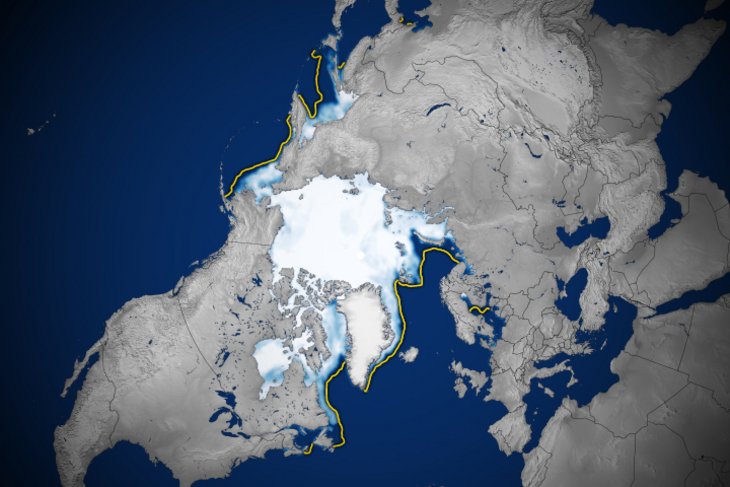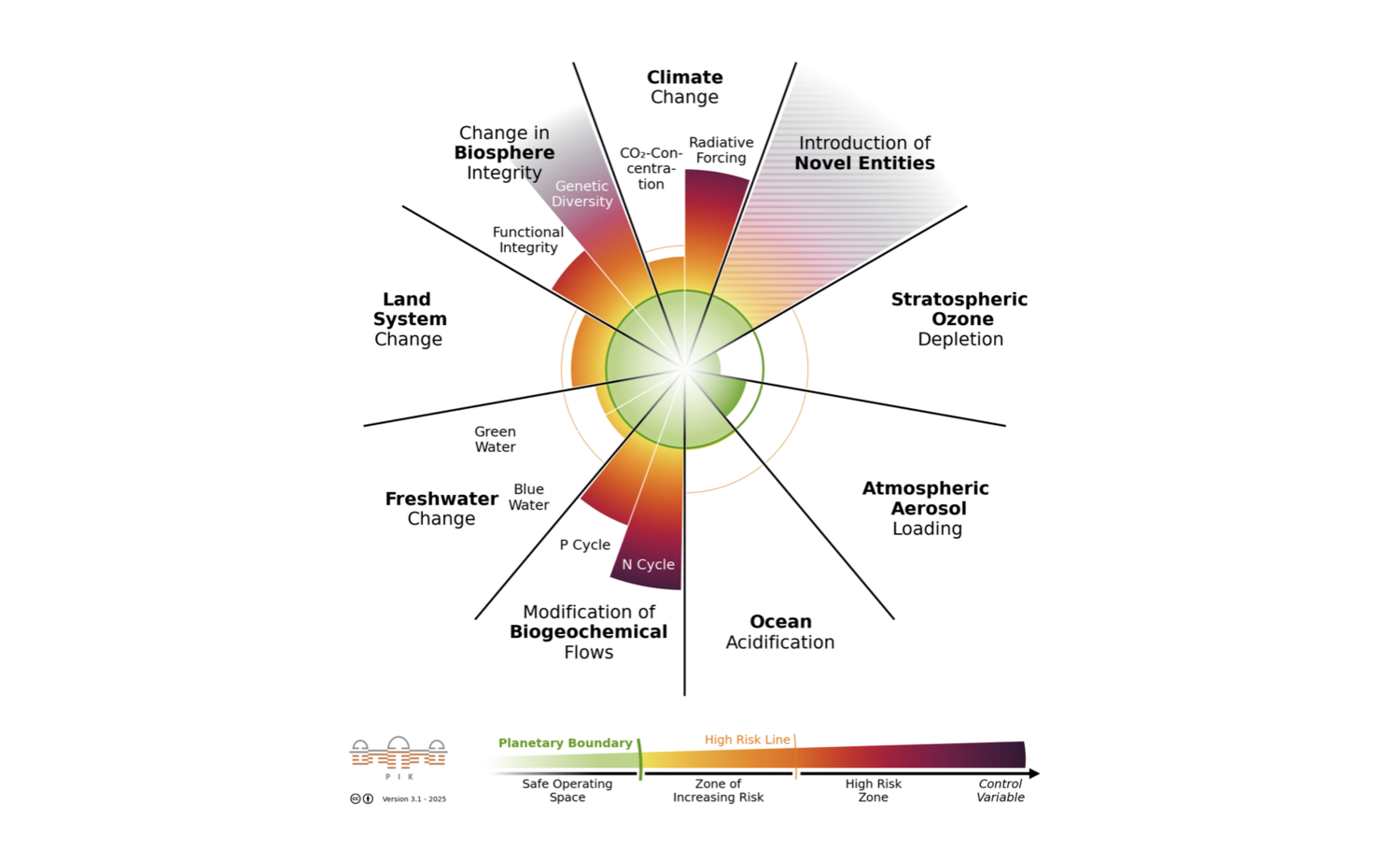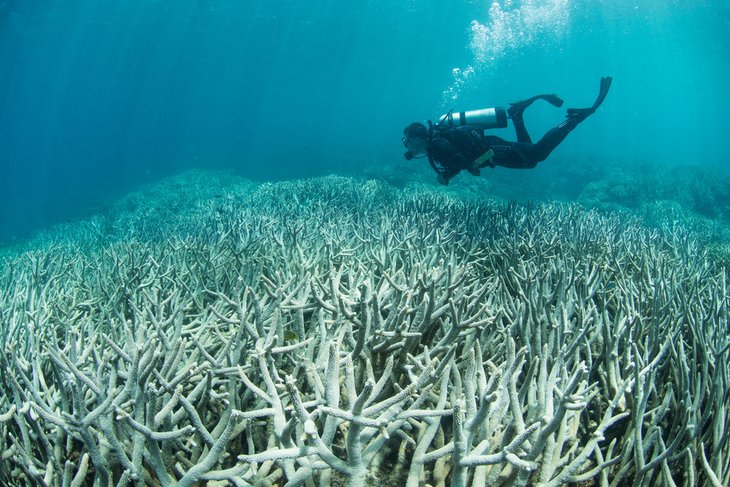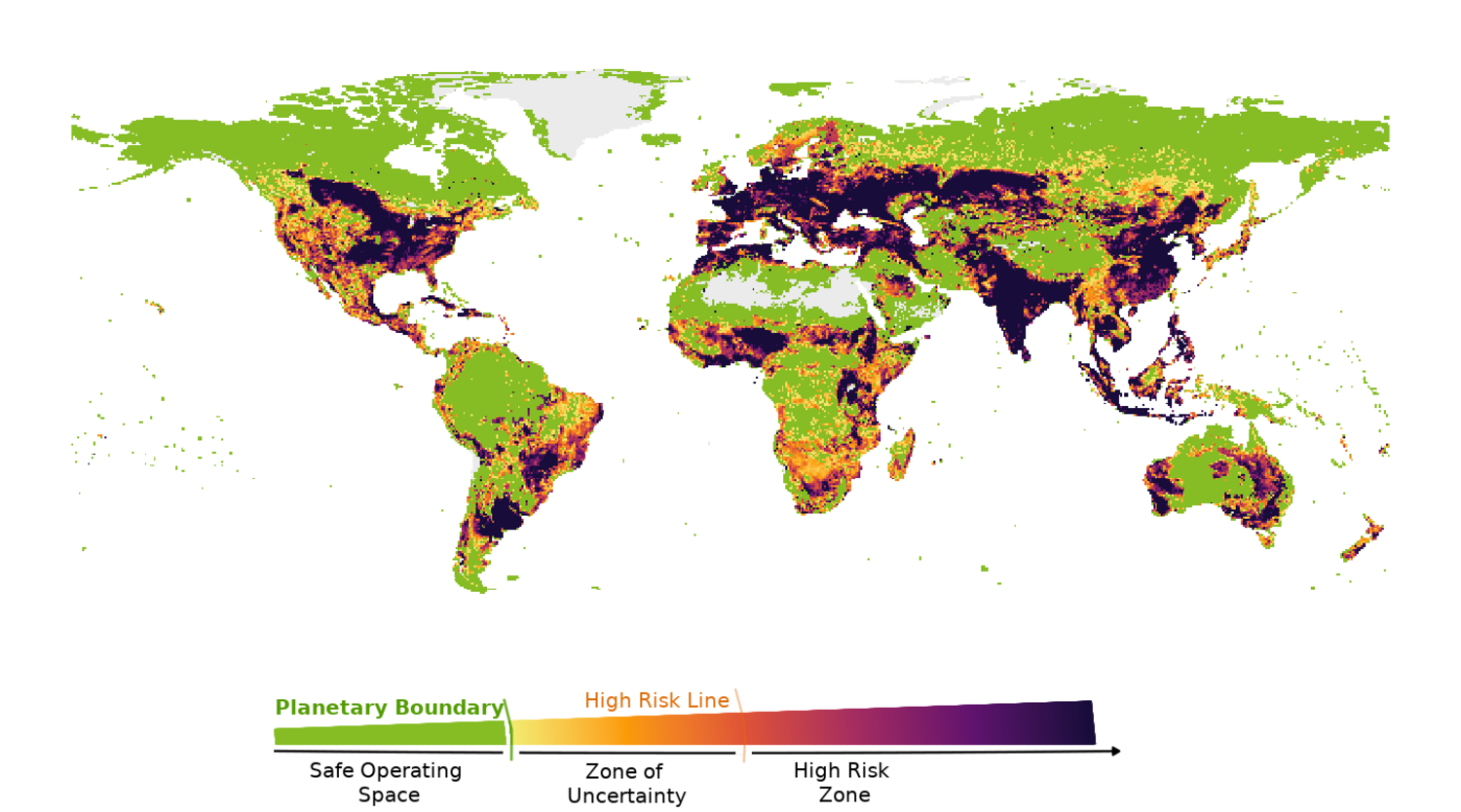
When news reports state that planetary boundaries have been exceeded, it is a warning that should be taken seriously. The concept of planetary boundaries is based on the idea that the health of the planet and our natural living conditions are affected by nine processes of global change.
These include:
- climate change;
- environmental overload with novel substances;
- the depletion of the ozone layer in the stratosphere;
- aerosol pollution of the atmosphere;
- acidification of the oceans;
- disruption to the nitrogen and phosphorus cycles of the Earth.
- changes in freshwater systems;
- changes in land use;
- changes to the biological diversity and integrity of the biosphere (Earth's habitat, including all living organisms and ecosystems).

1. Increasing risk of large-scale, abrupt environmental changes
Planetary boundaries are defined as the points at which the impact of individual processes, and the resulting environmental damage, become so significant that there is an increased risk of large-scale, abrupt or irreversible environmental changes. The effects of individual changes are not necessarily immediate or drastic. However, these processes interact with each other. This means they influence and reinforce each other.
The Federal Environment Ministry compares the planetary boundaries to the criteria of a check-up at the doctor's on its website:
'For example, someone with high blood pressure will not immediately have a heart attack. However, the higher blood pressure rises and the longer it remains above the level defined as 'healthy', the higher the risk. If this is compounded by high cholesterol and excess weight, the situation becomes critical.'
According to this concept, if we stay within the planetary boundaries as a society, we can prevent large-scale environmental change. Our home, Earth, would then remain in roughly the same condition that humanity has experienced for the past 10,000 years, enabling us to develop a modern civilisation. This would be a planet characterised by a reasonably stable, life-friendly climate, and an intact natural environment capable of providing sufficient clean water, oxygen, and food.
2. Viewing the Earth system as a whole
The concept of planetary boundaries has many strengths. One of these is that it provides a common framework through which we can understand the global environmental impact of human activity, and view and assess the state of the Earth system as a whole.
The boundaries identified by experts define a safe operating space. If humanity remains within this space, it can continue to exist safely based on current knowledge without endangering the Earth's climate, nature or biodiversity.
However, the opposite is true if we intervene significantly in the cycles by, for example, burning oil, gas and coal for energy, exploiting raw materials and resources, dumping waste in the sea, or converting forests and wetlands into farmland. This puts such pressure on the Earth system that it triggers the aforementioned global change processes, causing us to exceed planetary boundaries and leave the safe operating space.
3. A concept that is constantly evolving
The concept of planetary boundaries dates back to 2009. It was developed by an international team of 29 environmental scientists, and has been refined continuously ever since. In 2015, the experts involved identified climate change and changes in the integrity of the biosphere as 'central' boundaries, stating that both have the potential to cause the Earth system to shift into a new state if they are exceeded.

Eight years later, the team incorporated the concept of justice into the assessment framework. This means that the planetary boundaries were redefined to set thresholds for the environmental conditions necessary for planetary stability, as well as for the flourishing of societies, economies and ecosystems worldwide. The new thresholds are therefore significantly stricter than the previous values.
During this revision, the researchers were also able to substantiate the boundaries of all nine change processes with concrete figures for the first time. Due to a lack of data, this had only been possible for seven of the nine processes in 2009. In the 2023 update, the scientists concluded that six of the nine planetary boundaries had already been exceeded.
Two years later, in September 2025, ocean acidification became the seventh boundary to be officially crossed. The main cause is the burning of fossil fuels, exacerbated by deforestation and land use change. As a result, the oceans are increasingly losing their stabilising role in the Earth system. The consequences are already evident, according to the researchers: cold-water corals, tropical reefs and Arctic ecosystems are under pressure. Since the Industrial Revolution, the pH value of the ocean surface has fallen by around 0.1 units. This equates to an increase in acidification of between 30 and 40 per cent.
4. Popular in politics, questioned in science
The concept of planetary boundaries is receiving a lot of attention in science and society. Politicians are familiar with it, and some have used the idea of planetary boundaries to develop strategies for better management of the climate and nature. Among other things, the concept forms the guidelines for the German government's sustainability strategy.
However, it is not without controversy. Criticism has come, and continues to come, from the natural and social sciences, as well as the humanities. Some experts argue that it is extremely challenging to summarise complex, interacting risks with different geographical impacts into uniform global thresholds. There has also been discussion in recent years about whether the correct control variables were used to determine certain boundaries and whether the thresholds have already been exceeded.

The concept was also criticised for not giving sufficient consideration to the oceans. Changes in key processes, such as the global conveyor belt of ocean currents (thermohaline circulation), must be included, as must changes in the stratification of water masses. The latter, for example, influences how much oxygen reaches the ocean's depths from the surface. There are currently increasing signs of further extreme changes in the ocean. In addition to ocean acidification, which is mentioned in the concept, these include climate change-induced ocean warming and increasing marine pollution from plastics and chemicals. Other issues include the unchecked exploitation of raw materials, such as overfishing and sand mining, and the destruction of important coastal ecosystems through urban development and infrastructure projects.
The authors of the concept also highlight its weaknesses. For instance, the numerous interactions between the Earth, humans, and nature remain poorly understood. The researchers therefore urge the scientific community to continue developing integrated Earth system models. These models could be used to investigate precisely how human activities affect all components of the Earth system in the long term, and which processes are involved.
A 2024 study, for instance, revealed that global plastic pollution exacerbates all nine global change processes, including climate change, ocean acidification, biodiversity loss, and changes to land, lakes, and rivers.

Another study, conducted in the summer of 2025, examined changes in biodiversity and the integrity of the biosphere across all terrestrial areas of the planet. The study's findings show that the biosphere stress limit has now been exceeded in almost all areas of land where the original vegetation has been significantly altered, primarily for agricultural purposes. In other words, 60 per cent of the world's land areas are in a precarious state. These areas have already left the safe zone defined locally in terms of biosphere integrity. Furthermore, 38 per cent of these areas are in the high-risk zone.
5. Looking to the future: How can the world develop without ruining itself?
In May 2025, the authors' group took another step forward in their development. In a new study, they linked the concept of planetary boundaries with data from model-based future scenarios. This allowed them to demonstrate that, if we implement further measures in addition to comprehensive climate protection, we humans can halt and reverse the deterioration of the Earth's condition. Such measures include switching to a low-meat diet, halving food waste, and using water and nutrients more efficiently.
If we succeed in making these behavioural changes, the planet would be at least as healthy as it was in 2015 in almost every respect by 2050. It would also continue to recover in the second half of the century. However, even under these conditions, the planetary boundaries would still be exceeded by 2100, particularly with regard to climate change, the phosphorus and nitrogen cycles, biodiversity, and the integrity of the biosphere.
"The search for even better policy measures therefore remains on the agenda," said lead author Detlef van Vuuren when the results were published. Work on the concept of planetary boundaries therefore continues.
Further information in German:
Federal Ministry for the Environment, Climate Protection, Nature Conservation and Nuclear Safety: Planetary boundaries, www.bundesumweltministerium.de/themen/nachhaltigkeit/integriertes-umweltprogramm-2030/planetare-belastbarkeitsgrenzen
Further information in English:
- Biermann, F. & Kim, R. E. (2020): The Boundaries of the Planetary Boundary Framework: A Critical Appraisal of Approaches to Define a “Safe Operating Space” for Humanity. Annual Review of Environment and Resources, DOI: 10.1146/annurev-environ-012320- 080337
- Planetary Boundaries Science (PBScience). 2025. Planetary Health Check 2025. Potsdam Institute for Climate Impact Research (PIK), Potsdam, Germany. DOI: 10.48485/pik.2025.017
- Richardson, K. et al. (2023): Earth beyond six of nine planetary boundaries. Scientific Advances, DOI:10.1126/sciadv.adh2458
- Rockström, J., et al. (2009): Planetary boundaries: exploring the safe operating space for humanity. Ecology and Society 14(2): 32. [online] URL: www. ecologyandsociety.org/vol14/iss2/art32/
- Stenzel, F., et al. (2025): Breaching planetary boundaries: Over half of global land area suffers critical losses in functional biosphere integrity. One Earth, DOI:10.1016/j.oneear.2025.101393
- Stockholm Resilience Centre (2023): Planetary Boundaries. www.stockholmresilience.org/research/planetary-boundaries.html
- Tandon, A. (2023): ‘Safe and just’ climate boundary has already been breached, says contested study, CarbonBrief, www.carbonbrief.org/safe-and-just-climate-boundary-has-already-been-breached-says-contested-study/
- van Vuuren, D. P. et al. Exploring pathways for world development within planetary boundaries. Nature 641, 910–916 (2025), DOI:10.1038/s41586-025-08928-w
- Villarrubia-Gómez, P., Carney Almroth, B., Eriksen, M., Ryberg, M., & Cornell, S. E. (2024): Plastics pollution exacerbates the impacts of all planetary boundaries. One Earth. doi.org/10.1016/j.oneear.2024.10.017







